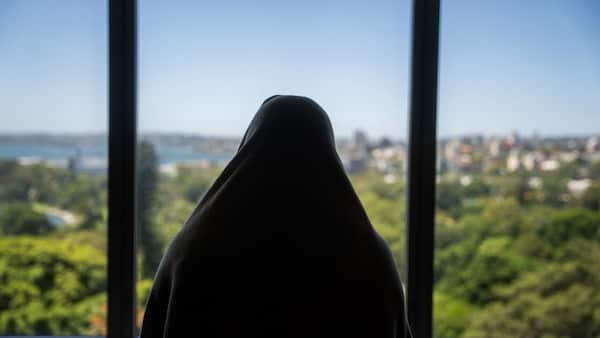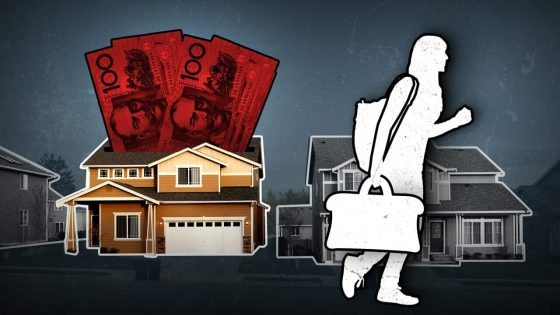This article contains references to domestic violence
Sally (not her real name) had endured over 20 years of abuse when she decided to leave her partner.
The mother of two says ending the relationship was a “choice of survival”.
But four years on, she often wonders if she made the right decision.
“I had support, but the financial part was crippling,” she told SBS News.
“The hell that not just I went through, but my kids went through, I often think now I should have just stayed until they were older and put some money aside.
“That says a lot, when a woman is willing to go and live in that level of abuse, because it’s so hard to leave.”
Leaving an abusive relationship left Sally financially crippled. Source: AAP / Diego Fedele
Over the course of her relationship, Sally was subjected to varying levels of physical, mental, emotional and financial abuse, as well as .
As her partner’s career progressed, she said the , in particular, “got worse and worse”.
“Even though he’d be earning more, I had to pay half of everything,” she said.
“I had no idea what was happening with our mortgage, what loans were being taken out, what credit cards were being taken out, where his money was going.”
Despite having a joint income of over $200,000, she said they’d often be broke.
“By all means, we should have been doing okay, but I would often have to borrow money off my mum.”
When Sally left the relationship in 2020, her abuser stopped paying the mortgage and didn’t provide her with any child support.
She ended up having to take out a $15,000 credit card after being rejected for a bank loan.
“The only thing I wanted was to keep the roof over my kids’ heads,” she said.
“I barely, barely held onto the house. It was by the skin of my teeth.”
Jane Lloyd, acting CEO of Australia’s National Research Organisation for Women’s Safety (ANROWS), said experiences like Sally’s weren’t uncommon.
“Our body of evidence shows that domestic and family violence does create financial barriers for victims and that women are most likely to bear the economic burden of violence,” she told SBS News.
“People often walk out with nothing, or even worse, debts, because their credit cards have been used and so forth, and they might not have been able to study or have their employment.”
What impact is the cost of living crisis having?
Financial stress was associated with an increased risk of women experiencing partner violence and abuse, according to the Australian Bureau of Statistics’ latest Personal Safety Survey.
The survey, which was conducted between 2021 and 2022, found women living in households with one or more cash flow problems were more likely to have experienced intimate partner violence or abuse in the previous two years than those who didn’t.
Research conducted by the Australian Institute of Criminology during the COVID-19 pandemic also .
Tara Hunter, director of clinical and client services at Full Stop Australia, which supports people who experience sexual, family, or domestic violence, said while increased stress in a household due to cost of living pressures may be one “facilitator” of abuse, it was never the sole reason a person was violent towards their partner.
“We need to be really mindful that we don’t have abusers saying, ‘Oh, I lost it because I’m under so much pressure financially’,” she said.
“That kind of rhetoric is not right.
“The bigger facilitator [of domestic and family violence] is someone making a choice to use violence and control as a means of responding to that stress.”
Women forced to stay in abusive relationships
Hunter said economic security was a “really major factor” in giving women choices to keep themselves safe.
But she said the cost of living crisis, and service and system challenges more broadly, were leaving many without a “safety net” — especially if they’re a victim of economic abuse.
“If you’ve got a partner that tracks all your finances and how you spend your money, you have no way of building up some sort of fund to actually escape.”
Lloyd said the costs associated with moving out of one home and having to set up a new one meant many victim-survivors were forced to stay in abusive relationships.
“The combination of having limited financial resources and then having to find somewhere to live compounds the challenge for victims,” she said.
“Having to look at the relocation costs, lack of affordable options in housing — that increases the likelihood of many people returning to the abusers.”
A lack of affordable housing is forcing many Australians to stay in violent relationships. Source: Getty / LOUISE BEAUMONT
Hunter said that even after they leave, the impact of violence can affect victim-survivors’ economic wellbeing “a long time into the future”.
She said that can be for a variety of reasons such as being left in debt, ongoing physical or mental health issues, and interruptions at work.
She said some perpetrators also continue to control and abuse their victims by using the family legal system against them, and try to get them fired.
After a protracted legal battle with her abuser, she was left with around $80,000 in ongoing debt, a “really really big mortgage”, and barely any superannuation.
“To this day, he works cash jobs so he doesn’t have to pay any child support or anything like that,” she said.
‘A drop in the ocean’
The federal government announced earlier this month that it would invest $925 million over five years.
The program will provide people fleeing domestic and family violence with up to $5,000 in financial support — an upfront cash payment of $1,500 and $3,500 on a pre-paid card for goods and services.
They will also receive access to referral services, risk assessments and safety planning.
But Hunter said in many cases, this figure is inadequate.
“The reality is, $5,000 is but a drop in the ocean.
“If we think realistically about how much it costs to move or to go from a double-income household to a single-income household, there’s some real challenges there if that’s your only economic support.”
The government has also committed $1 billion in Tuesday’s budget to crisis and transitional accommodation for women and children fleeing domestic violence, and young people.
“This is a welcome decision as too often people have had to return to violent situations to avoid homelessness or poverty,” Hunter said.
“By addressing the housing crisis, we create options for victim-survivors to be able to leave.
“Moving beyond the crisis point to medium-term responses allows for people, and their children, to also recover and heal.”
The need for long-term security
But Hunter said longer-term support was still necessary.
“We need to make these investments now and sustain them going forward,” she said.
“Addressing accommodation is just part of the picture, this investment must be backed in by resourcing front line services facing increasing demand.”
In the lead-up to the budget, there have been several calls to raise the rate of Jobseeker and other income support payments.
It was the priority recommendation in the government-appointed Economic Inclusion Advisory Committee’s (EIAC) 2024 report.
There have been several calls in the lead-up to the budget to raise the rate of Jobseeker and other income support payments. Source: AAP / TRACEY NEARMY/AAPIMAGE
Dozens of prominent women and non-binary people also signed an open letter to the prime minister last week, calling for a “substantial increase” to the Jobseeker and Youth Allowance payments.
“To find safety, women need to know they will have basic economic security over the longer term,” the letter said.
“Lifting social security payments will not negate the need to invest in frontline services and take the other critical steps to achieve women’s safety. However, it is a core part of ensuring women can do what they need to do in order to be safe.”
Treasurer Jim Chalmers said that while the government took the EIAC’s report “seriously”, it couldn’t implement every recommendation it made.
“We need to be cognisant of the budget situation and what we can afford. We don’t want to over‑promise and under‑deliver when it comes to our most vulnerable people,” he told reporters last Tuesday.
on Sunday, Chalmers said this year’s budget already contained significant investment in women’s safety.
But he acknowledged there was still “more work to do”.
“We want people to be able to make the right decisions for their safety. We want to support those choices. We want to fund the services and the assistance that people need, but for as long as women still aren’t safe in our community, we know there’s more work to do,” he said.
While Sally believes she would be better off financially had she stayed with her abuser until her children were older, leaving when she did has given her time to heal.
“I’m in a good space now,” she said.
“I don’t consider myself a victim. That’s like a past life, and I’m in my own lane now.”
Additional reporting by Anna Henderson
If you or someone you know is impacted by family and domestic violence or sexual assault call 1800RESPECT on 1800 737 732 or visit . In an emergency, call 000.
, operated by No to Violence, can be contacted on 1300 766 491.







